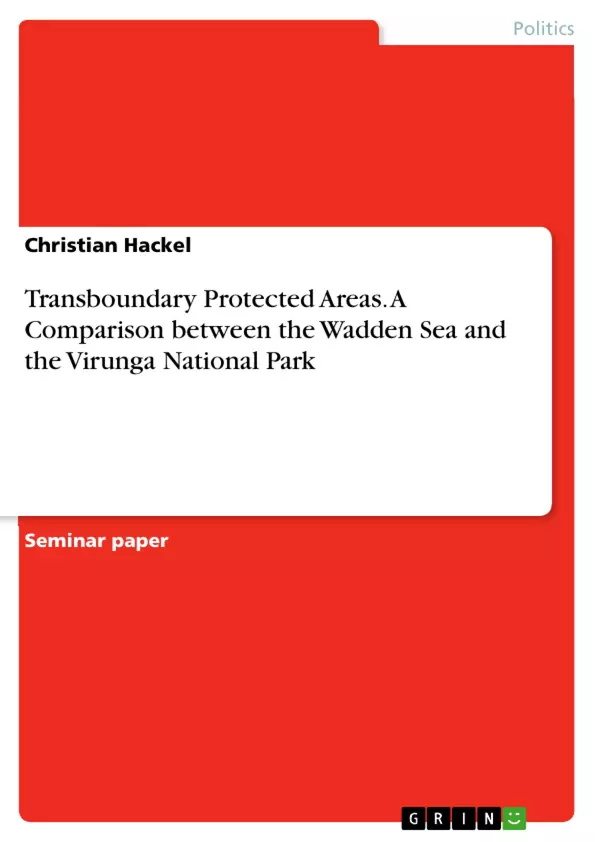This paper focuses on the effectiveness and equity of two transboundary conservation interventions (Wadden Sea & Virunga National Park), comparing their individual institutional structures and organizational contexts.
Many areas of the world, that are most vulnerable to climate change and biodiversity loss, are also home to large concentrations of indigenous peoples and poor local communities. For many years, conservation practices were mainly geared towards protecting wildlife and nature by separating it from humans. While this fortress approach may have helped to save threatened ecosystems and wildlife, insufficient recognition of equity had negative implications for indigenous peoples and
local communities.
In recent years, equity is gaining more prominence in global agreements, such as the Paris Agreement. In the context of conservation, equity is reflected in the Kunming-Montreal Global Biodiversity Framework under the Convention on Biological Diversity, which stipulates that equitably managed protected areas shall be expanded to 30% of our planet’s land and ocean and equitable participation of IPLC as well as respect for their resource rights are to be ensured.
Transboundary Protected Areas are “relatively large areas that straddle frontiers between two or more countries and cover large-scale natural systems, encompassing one or more protected areas”. Besides improved conservation outcomes, transboundary interventions are believed to serve other important purposes such as peacebuilding among nations.
Inhaltsverzeichnis (Table of Contents)
- Introduction
- Outline of the two case studies
- The Trilateral Wadden Sea Cooperation (TWSC)
- The Greater Virunga Transboundary Collaboration (GVTC)
- Comparison of the main environmental and social impacts
- Environmental Impacts
- Social Impacts
- Assessment of effectiveness and equity
- Effectiveness
- Equity
- Conclusion
- References
Zielsetzung und Themenschwerpunkte (Objectives and Key Themes)
This paper explores the effectiveness and equity of two transboundary conservation interventions, the Trilateral Wadden Sea Cooperation (TWSC) and the Greater Virunga Transboundary Collaboration (GVTC), comparing their individual institutional structures and organizational contexts.
- Transboundary Protected Areas (TBPAs) as a tool for conservation and regional cooperation
- The role of international agreements and institutional structures in TBPA management
- The environmental and social impacts of TBPAs
- Assessing the effectiveness and equity of TBPA management
- The challenges and opportunities of TBPA governance in different contexts
Zusammenfassung der Kapitel (Chapter Summaries)
The paper begins by introducing the concept of transboundary protected areas and their growing importance in global conservation efforts. The introduction highlights the shift towards incorporating equity considerations in conservation practices, particularly for Indigenous Peoples and Local Communities (IPLC).
Chapter 2 provides a detailed outline of the two case studies, the Trilateral Wadden Sea Cooperation (TWSC) and the Greater Virunga Transboundary Collaboration (GVTC), outlining their historical development, institutional structures, and key conservation objectives.
Chapter 3 compares the environmental and social impacts of the two case studies. The TWSC's focus on biodiversity conservation, sustainable tourism, and fisheries management is contrasted with the GVTC's experience with "green militarization" and the complex social dynamics surrounding conservation in a politically volatile region.
Chapter 4 delves into the assessment of effectiveness and equity in both case studies. The TWSC's success in achieving conservation targets is compared with the challenges faced by the GVTC in balancing conservation goals with community needs and political instability. The chapter examines the factors contributing to the varying degrees of success in each case study.
Schlüsselwörter (Keywords)
The core themes and concepts explored in this paper include Transboundary Protected Areas (TBPAs), biodiversity conservation, equity, effectiveness, governance, institutional structures, social impacts, environmental impacts, sustainable tourism, green militarization, Indigenous Peoples and Local Communities (IPLC), and the Trilateral Wadden Sea Cooperation (TWSC) and the Greater Virunga Transboundary Collaboration (GVTC) as case studies.
- Quote paper
- Christian Hackel (Author), 2023, Transboundary Protected Areas. A Comparison between the Wadden Sea and the Virunga National Park, Munich, GRIN Verlag, https://www.grin.com/document/1395576



